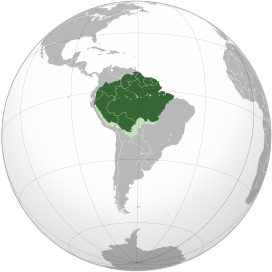**Geography and Natural History**:
– The Amazon rainforest covers most of the Amazon basin in South America.
– Brazil holds 60% of the forest, followed by Peru with 13%.
– Nine countries share the Amazon basin, with Brazil containing 58.4% of the rainforest.
– The rainforest likely formed during the Eocene era and has been in existence for at least 55 million years.
– The Amazon receives approximately 9 feet of rainfall annually.
– Climate fluctuations have allowed savanna regions to expand into the tropics.
– Evidence shows significant changes in vegetation over the last 21,000 years.
**Biodiversity and Flora/Fauna**:
– The Amazon rainforest holds unparalleled biodiversity.
– One in ten known species in the world lives in the Amazon.
– The region is home to about 2.5 million insect species.
– Scientists have classified tens of thousands of plants, 2,000 birds, and mammals.
– An estimated 438,000 species of plants of economic and social interest are in the region.
– One in five bird and fish species worldwide are found in the Amazon.
– The biodiversity of plant species in the Amazon is the highest on Earth.
– An estimated 16,000 tree species exist in the Amazon.
**Deforestation and Environmental Impact**:
– Large-scale deforestation in the Amazon is causing harmful effects.
– Economic losses in Brazil due to deforestation could be 7 times higher than commodity production costs.
– Deforestation is threatening the biodiversity of the Amazon rainforest.
– Efforts are being made to combat deforestation through conservation initiatives.
– Main sources of deforestation in the Amazon are human settlement and land development.
– Logging in the Amazon reduces precipitation and lowers crop yields.
– Deforestation declined between 2004 and 2014 but has increased again.
– Relaxation of regulations by Brazilian President Bolsonaro has led to more deforestation.
– Oil drilling and mining operations in the Amazon have further contributed to deforestation.
**Indigenous Peoples and Culture**:
– More than 30 million people from 350 different ethnic groups live in the Amazon.
– Indigenous peoples make up 9% of the total population.
– 60 groups remain largely isolated in the Amazon.
– Indigenous territories are formally acknowledged in the region.
– Conflicts and wars have historically occurred between different indigenous tribes in the Amazon.
**Historical Significance and Events**:
– Human settlements in the Amazon region date back at least 11,200 years.
– By AD 1500, an estimated 5 million people lived in the Amazon region.
– The first European to travel the length of the Amazon River was Francisco de Orellana in 1542.
– Evidence suggests a complex civilization thrived along the Amazon in the 1540s.
– Pre-Columbian agriculture in the Amazon Basin supported prosperous societies.
– The 2019 Amazon fires drew global attention to deforestation and environmental issues.
The Amazon rainforest, also called Amazon jungle or Amazonia, is a moist broadleaf tropical rainforest in the Amazon biome that covers most of the Amazon basin of South America. This basin encompasses 7,000,000 km2 (2,700,000 sq mi), of which 5,500,000 km2 (2,100,000 sq mi) are covered by the rainforest. This region includes territory belonging to nine nations and 3,344 formally acknowledged indigenous territories.
| Amazon rainforest Portuguese: Floresta amazônica Spanish: Selva amazónica Dutch: Amazoneregenwoud | |
|---|---|
 Map of the Amazon rainforest ecoregions as delineated by the WWF in dark green and the Amazon drainage basin in light green. | |
| Geography | |
| Location | Bolivia, Brazil, Colombia, Ecuador, French Guiana (France), Guyana, Peru, Suriname, and Venezuela |
| Coordinates | 3°S 60°W / 3°S 60°W |
| Area | 5,500,000 km2 (2,100,000 sq mi) |
The majority of the forest, 60%, is in Brazil, followed by Peru with 13%, Colombia with 10%, and with minor amounts in Bolivia, Ecuador, French Guiana, Guyana, Suriname, and Venezuela. Four nations have "Amazonas" as the name of one of their first-level administrative regions, and France uses the name "Guiana Amazonian Park" for French Guiana's protected rainforest area. The Amazon represents over half of Earth's remaining rainforests, and comprises the largest and most biodiverse tract of tropical rainforest in the world, with an estimated 390 billion individual trees in about 16,000 species.
More than 30 million people of 350 different ethnic groups live in the Amazon, which are subdivided into 9 different national political systems and 3,344 formally acknowledged indigenous territories. Indigenous peoples make up 9% of the total population, and 60 of the groups remain largely isolated.
Large scale deforestation is occurring in the forest, creating different harmful effects. Economic losses due to deforestation in Brazil could be approximately 7 times higher in comparison to the cost of all commodities produced through deforestation. In 2023, the World Bank published a report proposing a non-deforestation based economic program in the region.
